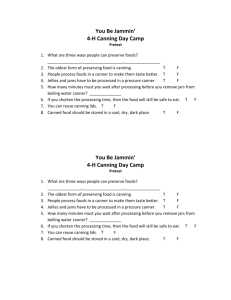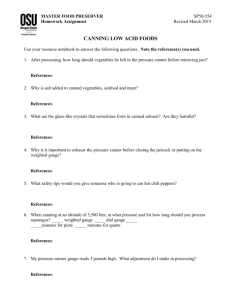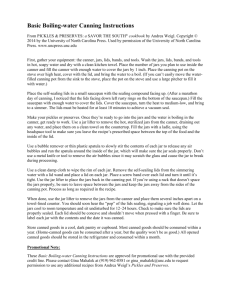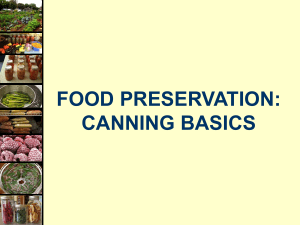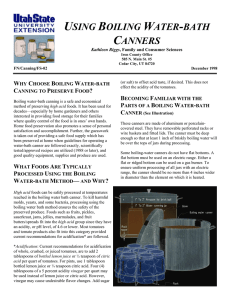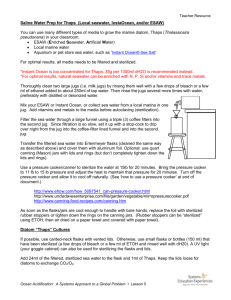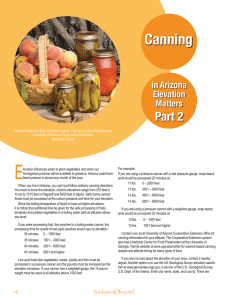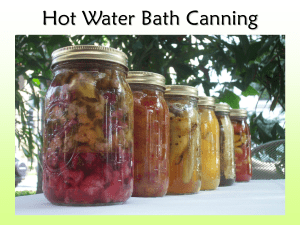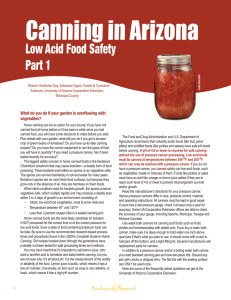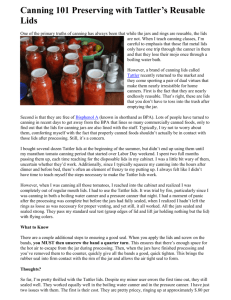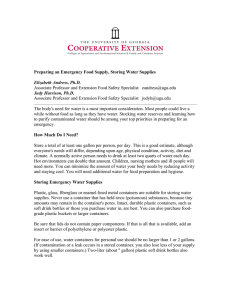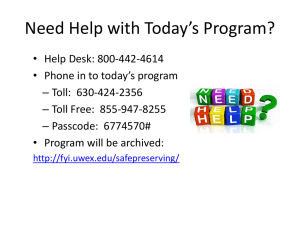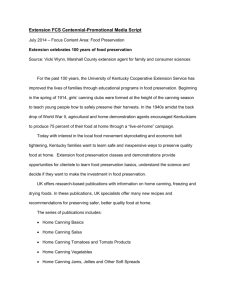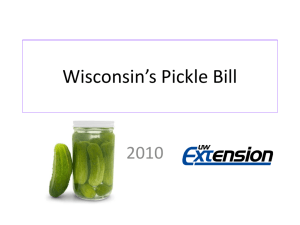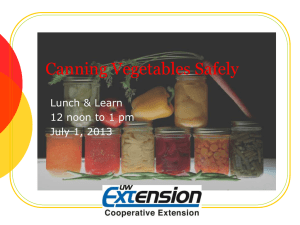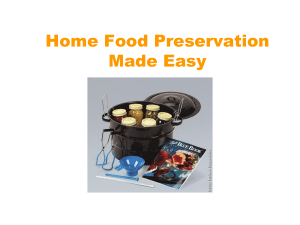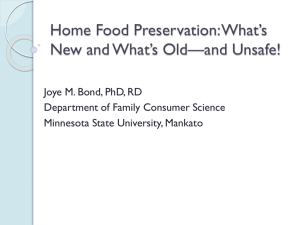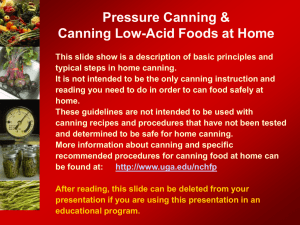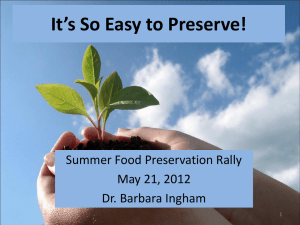GETTING READY TO CAN--Heidi Flowers Family and Consumer
advertisement
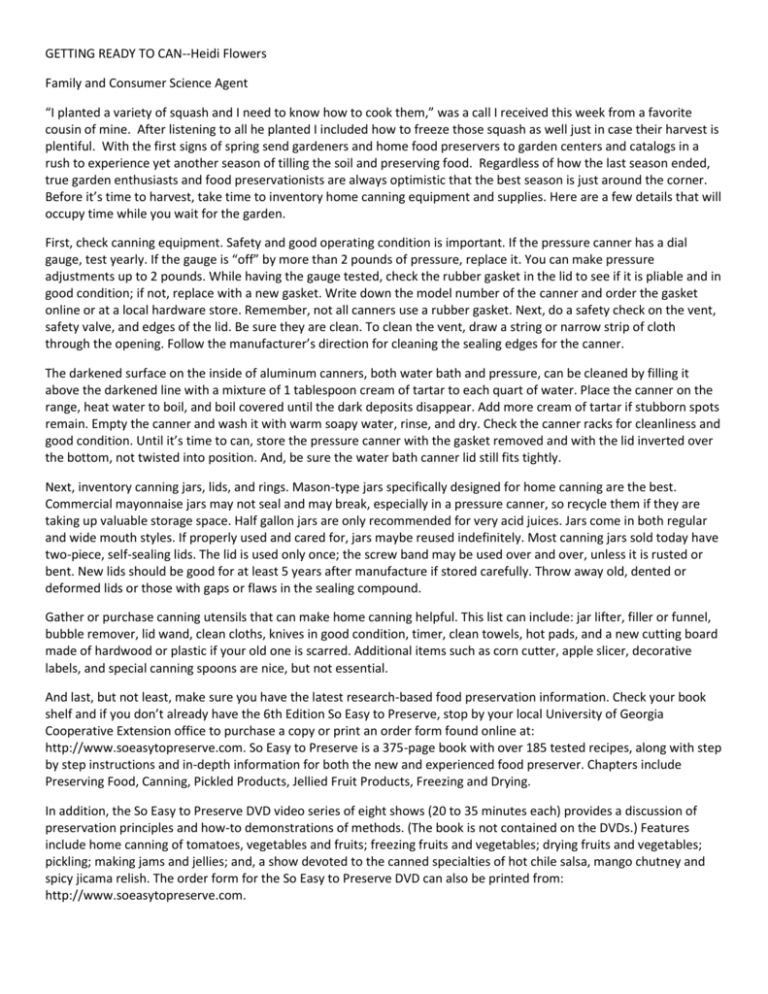
GETTING READY TO CAN--Heidi Flowers Family and Consumer Science Agent “I planted a variety of squash and I need to know how to cook them,” was a call I received this week from a favorite cousin of mine. After listening to all he planted I included how to freeze those squash as well just in case their harvest is plentiful. With the first signs of spring send gardeners and home food preservers to garden centers and catalogs in a rush to experience yet another season of tilling the soil and preserving food. Regardless of how the last season ended, true garden enthusiasts and food preservationists are always optimistic that the best season is just around the corner. Before it’s time to harvest, take time to inventory home canning equipment and supplies. Here are a few details that will occupy time while you wait for the garden. First, check canning equipment. Safety and good operating condition is important. If the pressure canner has a dial gauge, test yearly. If the gauge is “off” by more than 2 pounds of pressure, replace it. You can make pressure adjustments up to 2 pounds. While having the gauge tested, check the rubber gasket in the lid to see if it is pliable and in good condition; if not, replace with a new gasket. Write down the model number of the canner and order the gasket online or at a local hardware store. Remember, not all canners use a rubber gasket. Next, do a safety check on the vent, safety valve, and edges of the lid. Be sure they are clean. To clean the vent, draw a string or narrow strip of cloth through the opening. Follow the manufacturer’s direction for cleaning the sealing edges for the canner. The darkened surface on the inside of aluminum canners, both water bath and pressure, can be cleaned by filling it above the darkened line with a mixture of 1 tablespoon cream of tartar to each quart of water. Place the canner on the range, heat water to boil, and boil covered until the dark deposits disappear. Add more cream of tartar if stubborn spots remain. Empty the canner and wash it with warm soapy water, rinse, and dry. Check the canner racks for cleanliness and good condition. Until it’s time to can, store the pressure canner with the gasket removed and with the lid inverted over the bottom, not twisted into position. And, be sure the water bath canner lid still fits tightly. Next, inventory canning jars, lids, and rings. Mason-type jars specifically designed for home canning are the best. Commercial mayonnaise jars may not seal and may break, especially in a pressure canner, so recycle them if they are taking up valuable storage space. Half gallon jars are only recommended for very acid juices. Jars come in both regular and wide mouth styles. If properly used and cared for, jars maybe reused indefinitely. Most canning jars sold today have two-piece, self-sealing lids. The lid is used only once; the screw band may be used over and over, unless it is rusted or bent. New lids should be good for at least 5 years after manufacture if stored carefully. Throw away old, dented or deformed lids or those with gaps or flaws in the sealing compound. Gather or purchase canning utensils that can make home canning helpful. This list can include: jar lifter, filler or funnel, bubble remover, lid wand, clean cloths, knives in good condition, timer, clean towels, hot pads, and a new cutting board made of hardwood or plastic if your old one is scarred. Additional items such as corn cutter, apple slicer, decorative labels, and special canning spoons are nice, but not essential. And last, but not least, make sure you have the latest research-based food preservation information. Check your book shelf and if you don’t already have the 6th Edition So Easy to Preserve, stop by your local University of Georgia Cooperative Extension office to purchase a copy or print an order form found online at: http://www.soeasytopreserve.com. So Easy to Preserve is a 375-page book with over 185 tested recipes, along with step by step instructions and in-depth information for both the new and experienced food preserver. Chapters include Preserving Food, Canning, Pickled Products, Jellied Fruit Products, Freezing and Drying. In addition, the So Easy to Preserve DVD video series of eight shows (20 to 35 minutes each) provides a discussion of preservation principles and how-to demonstrations of methods. (The book is not contained on the DVDs.) Features include home canning of tomatoes, vegetables and fruits; freezing fruits and vegetables; drying fruits and vegetables; pickling; making jams and jellies; and, a show devoted to the canned specialties of hot chile salsa, mango chutney and spicy jicama relish. The order form for the So Easy to Preserve DVD can also be printed from: http://www.soeasytopreserve.com. Once home canning preparation is completed, inventory the food supply preserved from the previous year and plan for the current year yields. Plan to have enough food to enjoy fresh, preserve, give to friends, and share with neighbors. For more information or to get your copy of So Easy To Preserve (6th Edition) please contact your Family and Consumer Science Agent at 912-287-2456.
